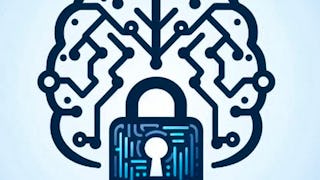The AI for Cybersecurity course offers a comprehensive introduction to the usage of AI methods, most specifically machine learning in the field of cybersecurity. It begins with an introduction to AI, covering its definitions, historical development, and general applications. The course then discusses the importance of AI in cybersecurity, introducing key concepts, and the distinction between the host security and the network security.



Recommended experience
Skills you'll gain
- Deep Learning
- Cyber Threat Intelligence
- Threat Detection
- Cybersecurity
- Natural Language Processing
- Anomaly Detection
- Information Systems Security
- Machine Learning
- Malware Protection
- Intrusion Detection and Prevention
- Supervised Learning
- Artificial Intelligence and Machine Learning (AI/ML)
- Artificial Intelligence
- Data Ethics
Details to know

Add to your LinkedIn profile
21 assignments
September 2025
See how employees at top companies are mastering in-demand skills

There are 4 modules in this course
Welcome to the introductory part of the AI and Cybersecurity course! During the 5 video lectures and 2 readings of this module you will find various definitions of the Artificial Intelligence, the evolution of this domain and the classification of the AI algorithms in search-based algorithms and intelligent systems. The domains where AI is successfully used are presented, with focus on the use of AI in cybersecurity related tasks (e.g.: network analysis, intrusion detection, malicious web link detection, anomaly detection or malware classification ). Afterwards, the basic concepts of cybersecurity will be introduced, and the classification of security threats at endpoint level or internet level. You will discover types of cybersecurity threats and how they can be defended.
What's included
12 videos7 readings7 assignments1 discussion prompt
Welcome to the second module of the AI for Cybersecurity course. This module consists of five lessons that explore different AI techniques and their applications in cybersecurity. It begins with an introduction to Machine Learning (ML) and its three basic types. The second lesson discusses three key cybersecurity tasks and explains how ML can be applied to address them. In the third lesson, you will follow a practical example of implementing and evaluating a malware detection system using two ML models: Decision Trees and Random Forests. The fourth lesson introduces fundamental concepts of deep learning (DL) and its applications in cybersecurity. Finally, the module concludes with an overview of Natural Language Processing (NLP) and how it can be used for cybersecurity-related tasks.
What's included
31 videos2 readings10 assignments
This module explores how AI techniques are applied to detect and mitigate online threats. It begins with an overview of malicious web links, explaining how they redirect users, run harmful code, and spread misinformation like fake news and phishing content. Detection methods are categorized into dynamic (e.g., sandboxing, honeypots) and static (e.g., URL analysis, blacklists, machine learning models). The module also details how URLs can be analyzed through lexical, host-based, and social media features. A special focus is given to Domain Generation Algorithms (DGAs), which malware uses to create deceptive domain names. Detecting DGAs is challenging and involves either manual feature extraction or automated learning methods. Another topic of this module is detecting fake news using deep learning modules. Finally, the presentation briefly talks about clickbait detection. Real-world case studies and research-backed solutions are presented throughout. By the end, learners are equipped to recognize key cyber threats and understand the AI models used to counter them.
What's included
5 videos1 reading2 assignments
This final module explores the ethical challenges and legal frameworks surrounding the use of AI in cybersecurity. Key concepts such as safety vs. security, risk management, and the balance between privacy and protection will be discussed. We will introduce the AI4People framework - autonomy, non-maleficence, beneficence, justice, and explainability - and examine its application to real-world cyber threats. The module also covers key regulations such as the EU AI Act, NIS2, the Cyber Resilience Act, and DORA, along with ethical guidelines from ACM, IEEE, and ISSA. Finally, we'll look at future trends, including open-source collaboration, ethical hacking, and global cooperation in securing AI systems. By the end, learners will understand the ethical and regulatory landscape and be prepared for the evolving challenges of AI in cybersecurity.
What's included
3 videos2 readings2 assignments
Offered by
Why people choose Coursera for their career




Explore more from Computer Science

Johns Hopkins University

Johns Hopkins University




